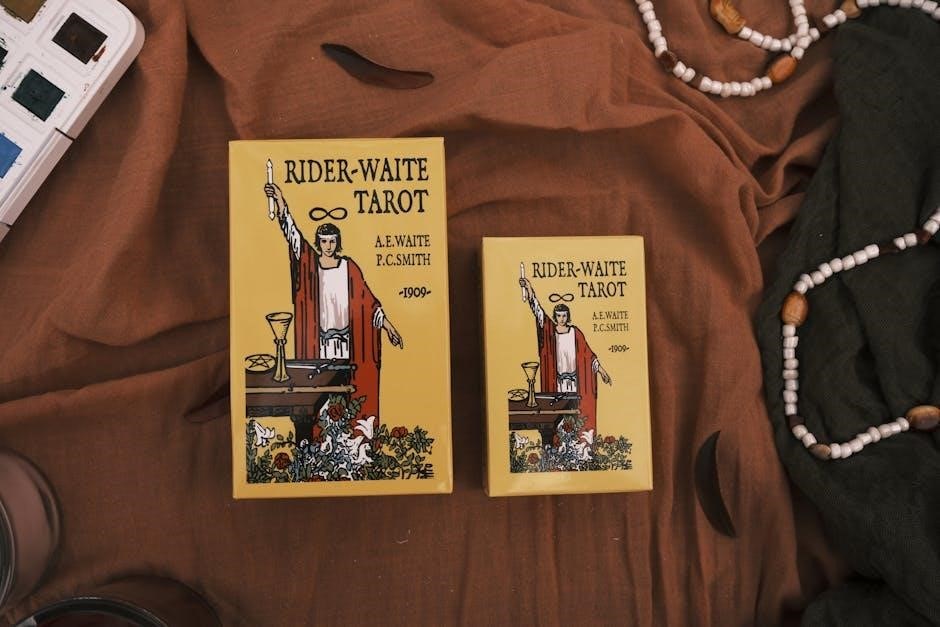The Rider Waite Tarot Guidebook is an essential resource for understanding the iconic deck, offering in-depth symbolism and card meanings. It serves as a bridge between the cards and the reader, providing a comprehensive guide to interpreting the deck’s imagery. The guidebook details the ten most important symbols on each card, accompanied by illustrations for easy reference. Its structured approach, beginning with reasons for its creation and continuing with a “this or that” exploration, makes it accessible for both beginners and experienced tarot enthusiasts. Perfect for self-discovery and divination, the guidebook is a valuable tool for mastering the Rider Waite Tarot.
Overview of the Rider Waite Tarot Deck
The Rider Waite Tarot Deck, created by Arthur Edward Waite and Pamela Colman Smith, was first issued in 1910. It is renowned for its detailed symbolism, making it accessible to both beginners and experienced tarot enthusiasts. The deck consists of 78 cards, divided into the Major Arcana and Minor Arcana, each with unique imagery. Its traditional yet profound approach has made it a cornerstone in tarot studies, offering a gateway to self-discovery and divination.
Importance of a Guidebook for Tarot Beginners
A guidebook is indispensable for tarot beginners, as it provides a clear understanding of the Rider Waite Tarot Deck’s symbolism and meanings. It serves as a foundational tool, offering detailed explanations of each card’s imagery and significance. For newcomers, the guidebook simplifies the learning process, helping them decipher the deck’s intricate symbols and themes. It also offers structured guidance, enabling beginners to build a strong foundation in tarot interpretation. By using a guidebook, learners can confidently navigate the deck, unlocking its deeper meanings and fostering a meaningful connection with the tarot.

History of the Rider Waite Tarot Deck
The Rider Waite Tarot Deck, created by Arthur Edward Waite and Pamela Colman Smith in 1909, is a seminal work in tarot history. First published in 1910, it revolutionized tarot by introducing detailed, symbolic illustrations for all 78 cards, making it accessible and popular worldwide.

Creation and Publication of the Rider Waite Deck

The Rider Waite Tarot Deck was created by Arthur Edward Waite and illustrator Pamela Colman Smith in 1909. It was first published in 1910 by William Rider & Son of London. Waite, a prominent occultist, designed the deck to reflect detailed symbolism, while Smith’s artistic interpretations brought the cards to life. The deck’s innovative approach included illustrated scenes for all 78 cards, including the Minor Arcana, which was groundbreaking at the time. This collaboration marked a significant shift in tarot design, making the Rider Waite deck one of the most recognizable and widely used tarot decks in the world. Its publication solidified its legacy.
Significance of Symbolism in the Rider Waite Tarot
Symbolism is the cornerstone of the Rider Waite Tarot Deck, as emphasized by Arthur Edward Waite. Each card’s intricate imagery conveys deeper meanings, making the deck a rich tool for interpretation. The guidebook highlights how symbols, such as celestial bodies, animals, and mythological figures, represent universal themes and personal truths. This approach allows readers to connect with the cards on multiple levels, enhancing intuition and understanding. The detailed illustrations by Pamela Colman Smith were designed to reflect Waite’s vision, ensuring every symbol aligns with its intended meaning. This focus on symbolism has made the Rider Waite deck a timeless resource for tarot practitioners worldwide.

Structure of the Rider Waite Tarot Guidebook
The guidebook features a comprehensive layout, detailing Major and Minor Arcana, symbolism, and practical applications. It includes a 26-page PDF with card meanings, zodiac, elements, and reversed interpretations.
Key Sections of the Guidebook
The Rider Waite Tarot Guidebook is divided into key sections that enhance understanding and practical use. It includes a detailed interpretation of each card, exploring symbolism, primary meanings, and prognostications. The guidebook also covers the Major and Minor Arcana, providing insights into their roles and significance. Additional sections focus on zodiac associations, elemental correspondences, and yes/no interpretations for each card. A 26-page PDF guidebook accompanies the deck, offering concise explanations and keywords for easy reference. This structured approach ensures that both beginners and advanced users can deepen their tarot knowledge and improve their reading skills effectively.
How the Guidebook Explains Tarot Symbolism
The Rider Waite Tarot Guidebook delves deeply into tarot symbolism, emphasizing its role as the core language of the deck. Each card’s symbols are meticulously explained, highlighting their individual meanings and how they collectively convey messages. The guidebook connects these symbols to universal themes and personal experiences, aiding readers in interpreting their relevance. It also provides interpretations for both upright and reversed cards, offering a nuanced understanding. Visual examples and keyword summaries are included to enhance comprehension, making the guidebook an invaluable tool for both beginners and experienced tarot enthusiasts seeking to master the symbolism of the Rider Waite deck.

Using the Guidebook for Tarot Readings
The Rider Waite Tarot Guidebook is a key tool for conducting meaningful tarot readings, offering structured interpretations and insights. It helps users formulate questions, interpret card meanings, and understand symbolism, making tarot accessible and impactful for both beginners and experienced readers.

Steps to Start Reading Tarot with the Guidebook
To start reading tarot with the Rider Waite Guidebook, begin by familiarizing yourself with the deck and its symbolism. Shuffle the cards while focusing on your question or intention. Draw the appropriate number of cards based on your chosen spread. Use the guidebook to interpret each card’s meaning, paying attention to its symbolism, position, and relationship to other cards. Practice with simple spreads like a three-card past-present-future layout. Reflect on how the guidebook’s explanations resonate with your intuition. Over time, combine the guidebook’s insights with your personal interpretations to deepen your tarot practice and enhance your readings.
Interpreting Card Meanings with the Guidebook
The Rider Waite Tarot Guidebook provides a structured approach to interpreting card meanings, emphasizing symbolism and its role in understanding the deck. Each card’s symbolism is explained in detail, with primary meanings and prognoses outlined for clarity. The guidebook also offers brief interpretations by topic, such as relationships, career, or spiritual growth, making it easier to apply the cards to real-life situations. By focusing on the symbolic language of the cards, the guidebook empowers readers to connect with the deck on a deeper level. Its comprehensive insights and practical examples make it an invaluable tool for both beginners and experienced tarot enthusiasts.
Major Arcana Cards in the Rider Waite Deck
The Major Arcana consists of 22 cards representing life’s journey and deep symbolism. Each card, like The Fool or The Lovers, offers profound insights into personal growth and destiny.
Understanding the Major Arcana
The Major Arcana consists of 22 cards, each representing significant life themes and transitions. These cards, such as The Fool and The Lovers, symbolize profound archetypes and universal experiences. The Rider Waite Tarot guidebook aids in interpreting their deeper meanings, revealing connections to personal growth, challenges, and spiritual journeys. By analyzing the imagery and symbolism, the guidebook helps readers understand how these cards reflect major life events and inner transformations. Each card in the Major Arcana offers insights into overcoming obstacles and embracing opportunities, making it a cornerstone of tarot readings for self-discovery and guidance.
Key Major Arcana Cards and Their Meanings
The Major Arcana includes 22 cards, each carrying profound meanings. Cards like The Fool symbolize new beginnings, while The Magician represents manifestation and skill. The High Priestess embodies intuition and hidden truths, while The Lovers highlight choices and relationships. Death signifies transformation and renewal, not literal endings. The World represents completion and fulfillment. Each card in the Major Arcana offers insights into life’s journey, guiding readers through challenges and triumphs. The Rider Waite Tarot guidebook provides detailed interpretations of these cards, helping users understand their symbolism and relevance to personal growth and decision-making.
Minor Arcana Cards in the Rider Waite Deck
The Minor Arcana comprises 56 cards across four suits: Wands, Cups, Swords, and Pentacles, symbolizing creativity, emotions, thoughts, and material aspects. The guidebook details their meanings and applications.

Structure of the Minor Arcana
The Minor Arcana in the Rider Waite Tarot Deck is divided into four suits: Wands, Cups, Swords, and Pentacles. Each suit contains 14 cards, including numbered cards from Ace to 10 and four court cards: Page, Knight, Queen, and King. This structure mirrors traditional playing cards but with tarot-specific interpretations. The suits correspond to different aspects of life—Wands for creativity and energy, Cups for emotions, Swords for thoughts and conflicts, and Pentacles for material wealth and practicality. The guidebook explains how each suit’s cards progress in meaning, from the Ace, representing new beginnings, through the numbered cards, which depict specific situations, to the court cards, symbolizing personalities or states of being. This clear organization helps users understand the interconnected themes and symbolism within the Minor Arcana.
Interpreting Minor Arcana Cards with the Guidebook
The Rider Waite Tarot Guidebook provides detailed interpretations of Minor Arcana cards, helping users understand their meanings in various contexts. Each card’s symbolism is explored, with explanations of primary meanings, prognoses, and reversed interpretations. The guidebook breaks down the significance of numbers and suits, offering insights into how Wands, Cups, Swords, and Pentacles relate to different life aspects. For example, the 5 of Cups is explained as reflecting emotional loss and nostalgia, while the 8 of Wands signifies progress and momentum. By connecting card themes to real-life situations, the guidebook empowers readers to apply Minor Arcana interpretations to personal growth and decision-making.
Practical Applications of the Guidebook
The Rider Waite Tarot Guidebook offers practical tools for self-discovery, enhancing tarot readings, and combining with other resources for deeper insights. It aids in personal growth and spiritual exploration, making tarot accessible to all.
Using the Guidebook for Self-Discovery
The Rider Waite Tarot Guidebook is a powerful tool for self-discovery, helping users explore their intuition and subconscious mind. By analyzing card symbolism, individuals can gain insights into personal challenges, desires, and life paths. The guidebook encourages reflection on how tarot imagery resonates with one’s experiences, fostering a deeper understanding of self. It provides a structured approach to introspection, enabling users to identify patterns and themes in their lives. This process of self-reflection can lead to personal growth, heightened self-awareness, and a clearer understanding of one’s journey, making the guidebook an invaluable resource for those seeking inner wisdom and transformation.
Combining the Guidebook with Other Tarot Resources

Enhancing your tarot practice by combining the Rider Waite Tarot Guidebook with other resources can deepen your understanding and versatility. Supplementary books like “Holistic Tarot” or “Kitchen Table Tarot” offer additional insights and techniques, while printable tarot cards provide a hands-on learning experience. Digital tools and apps can also complement the guidebook, offering instant access to card meanings and symbolism. By integrating these diverse resources, you create a well-rounded approach to tarot study, fostering a richer and more dynamic practice. This holistic method allows for continuous growth and adaptation, making your tarot journey both fulfilling and evolving over time.
The Rider Waite Tarot Guidebook is a comprehensive resource for mastering the iconic deck, offering deep insights into symbolism and card interpretations. It bridges the gap between the cards and the reader, making it indispensable for both beginners and experienced tarot enthusiasts. With its detailed explanations and structured approach, the guidebook is a valuable tool for anyone seeking to deepen their understanding of the Rider Waite Tarot and enhance their practice.
Final Thoughts on the Rider Waite Tarot Guidebook
The Rider Waite Tarot Guidebook is a vital resource for anyone exploring the Rider Waite deck, offering a deep dive into its symbolism and meanings. Its structured approach ensures accessibility for both beginners and advanced practitioners, making it an indispensable tool for tarot enthusiasts. By detailing the significance of each card and providing practical insights, the guidebook empowers users to enhance their readings and personal growth. Whether for self-discovery or professional use, the Rider Waite Tarot Guidebook remains a cornerstone for understanding and mastering the iconic deck, encouraging a lifelong journey of exploration and deeper connection with tarot.

Encouragement to Explore Tarot Further
Embrace the journey of tarot discovery with the Rider Waite Tarot Guidebook as your compass. This guidebook not only illuminates the symbolism of the Rider Waite deck but also invites you to deepen your understanding of tarot as a tool for self-discovery and personal growth. Whether you’re a beginner or an experienced reader, the guidebook’s insights will inspire you to explore beyond the basics. Combine it with other resources, such as printable cards or additional books, to enrich your practice. Let the guidebook be your starting point, and allow tarot to become a lifelong companion on your path to inner wisdom and empowerment.



Leave a Reply
You must be logged in to post a comment.